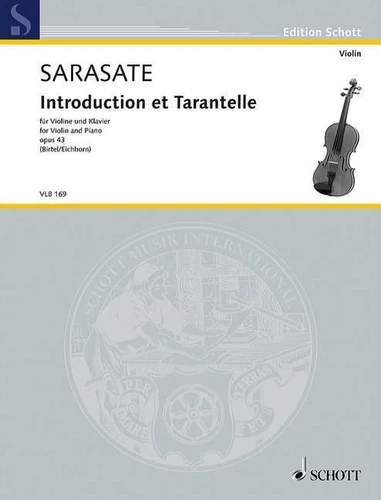Edition Schott
Introduction et Tarantelle. op. 43. violin and piano.
Par : Formats :
- Paiement en ligne :
- Livraison à domicile ou en point Mondial Relay indisponible
- Retrait Click and Collect en magasin gratuit
- Réservation en ligne avec paiement en magasin :
- Indisponible pour réserver et payer en magasin
- Nombre de pages26
- Poids0.131 kg
- Dimensions23,1 cm × 30,3 cm × 0,0 cm
- ISBN979-0-001-18958-3
- EAN9790001189583
- Date de parution01/01/2013
- CollectionVIOLIN LIBRARY
- ÉditeurSchott
- EditeurWolfgang Birtel
- EditeurFriedemann Eichhorn
Résumé
Pablo de Sarasate (1844-1908), undoubtedly, is one of the most important and most successful violin virtuosos of the second half of the 19th century and has become immortal through his virtuoso and highly expressive bravura pieces in the world of violin playing. His concert programme mostly consisted of his own compositions, even if quite a few works had been dedicated to him by fellow composers and tailor-made for him : for example, 'Symphonie espagnole' by Lalo, 'Scottish Fantasia' by Bruch and violin works by Saint-Saëns and Wieniawski.
In 1899 Sarasate composed one of his most popular, non-Spanish pieces, 'Introduction & Tarantella' Op. 43, which was published in the following year, even in a version with orchestra accompaniment. The tarantella, a folk dance in 6/8 metre, comes from southern Italy and has developed from dance tunes played in Apulia for people suffering from tarantism. According to popular belief, the bite of a tarantula caused tarantism which was supposed to be cured by wild dancing.
Go and try if Sarasate's salon piece really has medicinal properties ! Instrumentation : violin and piano op. 43
In 1899 Sarasate composed one of his most popular, non-Spanish pieces, 'Introduction & Tarantella' Op. 43, which was published in the following year, even in a version with orchestra accompaniment. The tarantella, a folk dance in 6/8 metre, comes from southern Italy and has developed from dance tunes played in Apulia for people suffering from tarantism. According to popular belief, the bite of a tarantula caused tarantism which was supposed to be cured by wild dancing.
Go and try if Sarasate's salon piece really has medicinal properties ! Instrumentation : violin and piano op. 43
Pablo de Sarasate (1844-1908), undoubtedly, is one of the most important and most successful violin virtuosos of the second half of the 19th century and has become immortal through his virtuoso and highly expressive bravura pieces in the world of violin playing. His concert programme mostly consisted of his own compositions, even if quite a few works had been dedicated to him by fellow composers and tailor-made for him : for example, 'Symphonie espagnole' by Lalo, 'Scottish Fantasia' by Bruch and violin works by Saint-Saëns and Wieniawski.
In 1899 Sarasate composed one of his most popular, non-Spanish pieces, 'Introduction & Tarantella' Op. 43, which was published in the following year, even in a version with orchestra accompaniment. The tarantella, a folk dance in 6/8 metre, comes from southern Italy and has developed from dance tunes played in Apulia for people suffering from tarantism. According to popular belief, the bite of a tarantula caused tarantism which was supposed to be cured by wild dancing.
Go and try if Sarasate's salon piece really has medicinal properties ! Instrumentation : violin and piano op. 43
In 1899 Sarasate composed one of his most popular, non-Spanish pieces, 'Introduction & Tarantella' Op. 43, which was published in the following year, even in a version with orchestra accompaniment. The tarantella, a folk dance in 6/8 metre, comes from southern Italy and has developed from dance tunes played in Apulia for people suffering from tarantism. According to popular belief, the bite of a tarantula caused tarantism which was supposed to be cured by wild dancing.
Go and try if Sarasate's salon piece really has medicinal properties ! Instrumentation : violin and piano op. 43


